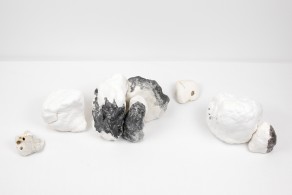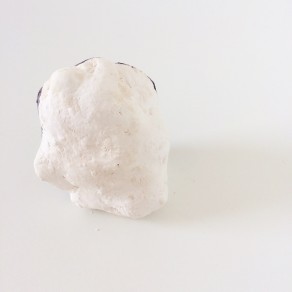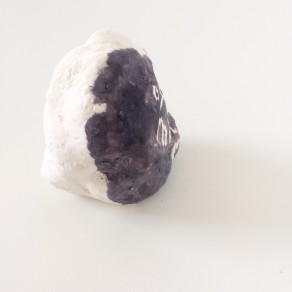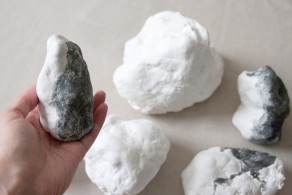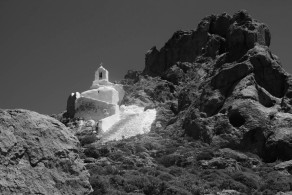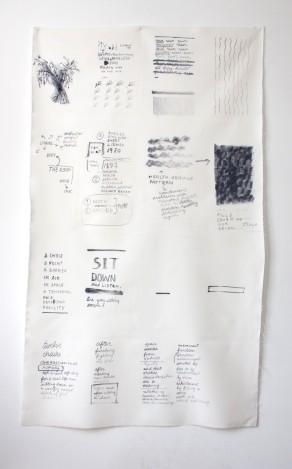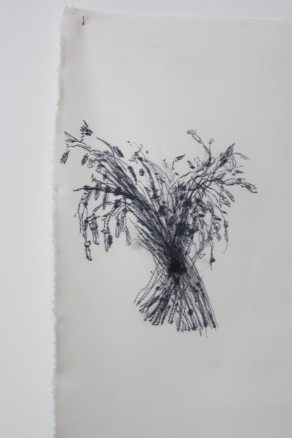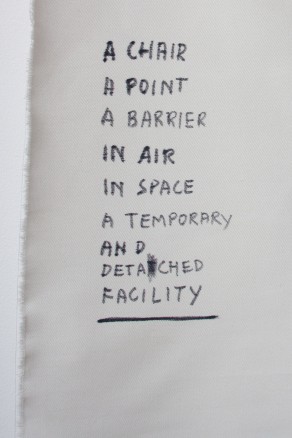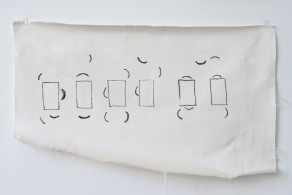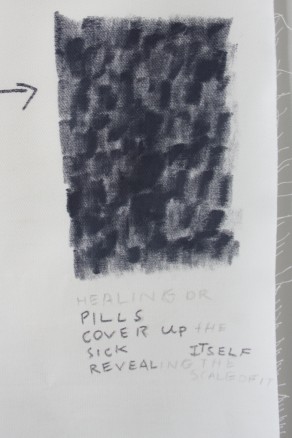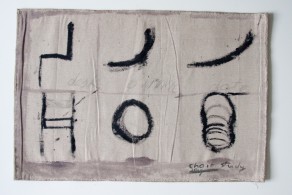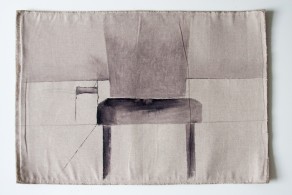Artist residency, Centre for Recent Drawing in partnership with Poetry Library, London, 2018
One month long artist residency resulted in Sit Down and Listen, a selection of visual studies: paintings, sketches and objects. Project looks into adaptivity (acceptance) and familiarity of spaces and objects utilised on daily basis. This selection of artworks proposed focus on a shared/public space (rather than home). Through observation and documentation of conversations of local people, project also collects and brings external strings of information from other countries and facts back from the history. Overall, through discreet and subtle use of materials a study of objects is displayed presenting new realities. Could they appear familiar to anyone else?..
Materials include conflicting selection: homely pure textiles and man made (fake) rocks (plaster), a landscape drawing is that of a chair and a drawing which becomes a docu-diagram amongst other poetic plays.
“The room was small but strangely there were 7 chairs!.. I also drew flowers which were about to dry out in a vase. I continued observing the chairs by making diagrammatic drawings of them in new positions daily. I then drew a study of a chair (side and front view) noticing how surprisingly comfy or strict and flat they might be. However, a chair basically is designed to seamlessly make you sit, lower your head and has mostly perfect space to lay your hands on a table. I also drew a chair landscape to further constructively analyse the chair and its relation to the bigger picture...
Outside I was making notes (as I do) of words I picked up from passers by on the street, facts that caught my eyes from current news or history. Amongst others, three things stood out in relation to my dying flowers and chairs at the time of making drawings:
- acid attacks were on the news, which made me think of the NHS, death and war, and the mental health issues this can lead to;
- I over-heard someone talk about how Victorian’s used to bun their hair upwards, which reminded me of the overall huge change that the Industrial revolution sparked which very much changed how the world operated;
- I accidentally came across a wall-paper pattern that week, which made me realise that that is what pattern knows: pattern only runs up and down, that’s its nature.
I drew those facts and key observations as a one typo-graphic mind map on a large sheet of silk, it worked as a summary but also a springboard to reflect, remove or elaborate on particular points. I eventually concluded that it is the chair that draws together all facts and objects noted so far. Decisions are made while sitting on a chair by medics, politicians (even I was doing my work while sat on the chair). The chair – a sort of authoritarian and regime enforcing object.
While lingering on the notion of a chair acting as an object of control I came to further conclusion: a chair reveals or MARKS the passive or active states of mind, as if one entering a new territory. This reminded me of a chapel in Greece painted pure white. Except the white paint never had a particularly determined edge: it was either on the rocks or on the dry grass… I noticed similar paint phenomenon on city buildings: one house colour may suddenly change to another or an area of a wall for some reason would just be in a totally different colour. This is like 21st century cave paintings, I thought. However, it was more about the man needing to make a mark: a man-made mark. The nature of the plaster made me work fast. There was no other choice. Out they came fast.
While the chair acts as a line in space, a barrier in time, yet its meaning trully raises once new obstacles appear for new generations... It will never stop, the chairs will be designed again and again, new decisions made again and again. Right or wrong, the pattern only knows to run, run run up and down… The man will keep on making the mark, artistic or not.
My final installation outcomes – drawings as study of the chair and the marked fake rocks – both tap into the questions of power, authority, territory and freedom. I have written a long poem using all the key words from the development stages, but I realised that to me poetry lies in the silence of visualised objects.”
_
With thanks to the Poetry School and Centre for Recent Drawing and all the artists and visiting artists who made this residency happen. Interview available here here on the Poetry School blog.
You may find out more about neringastudio current, future and past projects on Instagram, Twitter, Facebook Page or Vimeo.
